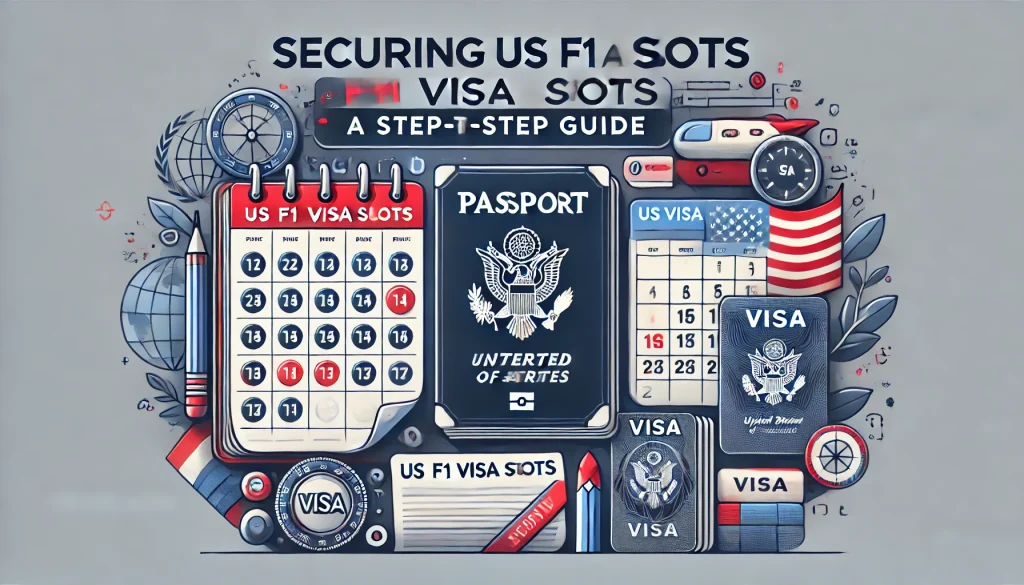
A Complete Guide to the US F1 Visa Process The F1 visa is a non-immigrant student visa that permits foreign students to attend recognized universities in the US. It is imperative that prospective students who want to pursue their academic objectives in the United States comprehend the complexities of the F1 visa application process. A. The first step in the process is to fully comprehend the prerequisites and procedures needed to obtain this visa. When a student is accepted into a school that has been approved by the Student and Exchange Visitor Program (SEVP), the process usually begins with the issuance of a Form I-20, a crucial document that verifies the student’s eligibility for the F1 visa and provides program details. The following stages of the visa application procedure require this form.
After obtaining your Form I-20, it is crucial that you become acquainted with the particular requirements that the U.S. S. . The State Department. This entails being aware of any extra paperwork that your selected institution might require in addition to the financial documentation required to demonstrate your ability to support yourself while pursuing your education.
To prevent delays or issues, it is essential to remain organized and knowledgeable about every step of the sometimes complicated F1 visa application process. Students who have a thorough understanding of the procedure will be better equipped to apply successfully and eventually fulfill their educational goals in the United States. It is crucial to investigate available F1 visa slots prior to beginning the application process. Numerous variables, such as shifts in immigration laws, seasonal patterns in student applications, and geopolitical events, can affect the demand for F1 visas. It is important for prospective students to monitor the U. S.
embassy or consulate’s website in their nation of residence for information on visa availability & any notifications about modifications to processing schedules or appointment times. Students can better organize their applications and steer clear of last-minute surprises by taking this proactive approach. Students who want advice on when to apply for an F1 visa should also think about contacting the educational institutions of their choice. Numerous universities have special offices for international students, which can offer helpful advice on the visa application procedure. These offices may also provide workshops or other resources to assist students in navigating the challenges of obtaining an F1 visa.
Potential students can increase their chances of getting an appointment on time and successfully obtaining their F1 visa by being informed and making use of the resources that are available. Making an account on the U.S. S. . System for Appointing Visas. Making a profile on the U.S.
is the next step after you have a clear idea of the F1 visa slots that are available. S. System for Appointing Visas. You can schedule appointments, monitor the status of your application, and get critical updates from the U.S.
government with this online platform, which is crucial for managing your visa application process. S. consulate or embassy. Details needed to create a profile. You must enter personal information like your name, birthdate, passport details, and contact details in order to create a profile.
It is essential to confirm that all of the information you enter is correct and corresponds to the information on your Form I-20 and passport. Simplifying the Application Process. You will have access to a number of tools that can expedite the application process once you have created your profile. For example, you can choose the time that works best for you by viewing the available appointment slots for your visa interview. You can stay organized throughout the process by using the system to receive helpful reminders about impending deadlines or necessary paperwork. Advantages of the U.S.
A. System for Visa Appointments. Students can efficiently handle their F1 visa applications and lower the possibility of mistakes or oversights by utilizing this online tool.
In order to apply for an F1 visa, you must pay the visa application fee, which is also referred to as the Machine Readable Visa (MRV) fee. Payment of this non-refundable fee is required prior to the appointment for your visa interview. It is crucial to confirm the precise fee that applies to your circumstances in the United States, as the amount varies based on your nationality and the type of visa you are applying for. S.
the website of an embassy or consulate. Different embassies may require different payment methods; some may require payment through specific banks or payment centers, while others may accept credit card payments online. As evidence of payment, it’s crucial to save a copy of your receipt after making the purchase. Keep this receipt in a secure location with your other important documents because you will need it for your visa interview. Also, be advised that certain applicants might also be required to pay an extra SEVIS fee, which is used to support the Student & Exchange Visitor Information System (SEVIS), which keeps track of foreign students studying in the United States.
S. . Comprehending these charges and making sure to pay on time are essential for a seamless application procedure. After paying the application fee and creating your U profile. S. Visa Appointment System: You can now set up an appointment for your F1 visa interview.
Depending on demand & local processing times, scheduling an appointment can occasionally take weeks or even months, making this step one of the most important ones in the application process. To guarantee that you have enough time to get ready for your interview & handle any possible problems, it is best to schedule your appointment as soon as possible. Be ready to provide details about your intended program of study and your SEVIS ID number, as well as other information from your Form I-20, when you make your appointment. You must also decide on a time and date that suits you, taking into account any travel schedules or academic program deadlines.
A confirmation email containing crucial information about your interview and any extra paperwork you might need to bring will be sent to you after your appointment has been successfully scheduled. The key to success in the F1 visa interview is preparation. Gathering all required paperwork & rehearsing answers to possible interview questions are part of this step.
Proof of financial support (such as bank statements or scholarship letters), your passport, Form I-20, and any academic records (such as transcripts or diplomas) are usually considered essential documents. For convenient access during your interview, it is advised that you arrange these documents neatly in a folder. It can also be helpful to have copies of all documents on hand in case the consular officer requests them.
Getting ready for typical interview questions that might come up during your appointment is just as important as gathering documents. Inquiries frequently center on your educational background & the factors that led you to select a particular American university. S. . as well as your post-study plans.
You can boost your confidence & make sure you speak clearly during the interview by practicing your responses with friends or family. Being organized shows that you are dedicated to studying in the United States. S. in addition to reducing anxiety on the day of the interview. The key is to prepare.
It is important to get to the embassy or consulate well in advance of the time you have been scheduled to appear on the day of your F1 visa interview. This covers any unanticipated hold-ups, like lengthy lines at the entrance or security checks. During interviews, first impressions are crucial, so present yourself professionally and keep a cheerful attitude the entire time. Checkpoints for arrival & security. Before you can enter the consular area upon arrival, you will need to show your appointment confirmation at security checkpoints along with other necessary documents.
To guarantee a seamless and effective procedure, this step is crucial. The interview procedure. Keep your cool and respond to the consular officer’s questions during the actual interview. Answer questions honestly & directly; it’s okay to ask for clarification if you don’t understand a question rather than speculating about the answer.
The officer will evaluate both your intentions to study in the United States & your eligibility for an F1 visa. S. so expressing sincere excitement for your academic endeavors can benefit you. Getting a Decision.
Following your completion of all the questions, you will either be notified of the status of your visa or of any further actions that need to be taken before a decision is made. Following your F1 visa interview, it is crucial to inquire about the status of your application if you do not hear back right away about its approval or rejection. Applicants can use their passport number or case number from their interview to check their visa status online through the tracking systems offered by the majority of embassies. Without having to get in touch with the embassy directly, this feature enables students to be updated on any developments pertaining to their application. Following your interview, if the consular officer asks for more information or documentation, be sure to answer fully and promptly to prevent needless delays in the processing of your visa application. Applicants might occasionally be asked to come back for a second interview or present more proof of their financial stability or national connections.
Maintaining your initiative throughout this phase shows dedication & can have a big influence on how your application process turns out. Finally, negotiating the U.S. S. From comprehending the initial requirements to following up after interviews, the F1 visa process necessitates meticulous preparation and attention to detail at every stage. In order to increase their chances of securing an F1 visa and starting their academic journey in the United States, prospective students should be informed & ready for this journey.



